When we first decided to venture into beekeeping, one of the considerations was where would we source our bees? The two most common, and economical choices, are either to catch a swarm, or to purchase bees in a ‘package’ from a commercial apiary. Not sure if we’d be able to source a swarm this spring, this winter we pre-ordered two packages of bees as part of a large group order through a local beekeeper’s guild.
We didn’t expect we’d have bees until our packages arrived. Doing things a little backwards we managed to catch a large swarm at the end of March, and a smaller afterswarm from the same colony in mid-April. Our package bees were delayed by a few weeks because the weather was so bad in March in California, that Queen breeding schedules at the apiary were delayed. On Thursday afternoon though our package bees finally arrived.
As this was part of a much larger group order, one member from the guild rented a truck and collected the packages from the apiary, and brought them to a nearby location for pickup.
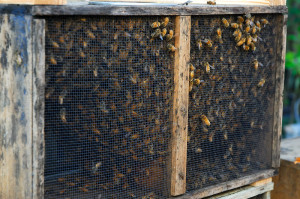
Bees tend to attract other bees, so before putting the package in the car, the loose bees were brushed off the outside
In the early evening on Thursday we collected two packages of Italian bees, each containing 3lbs of worker bees and a Queen, and placed them in the car to bring them home.

Roughly 10,000 extra passengers were riding in this package in the car...the other 10,000 were behind my seat
We don’t usually transport 20,000 Italians in the back seat of our car, but the package containers were secure, and fortunately these passengers were well behaved.
Unlike a swarm, these bees were not known to each other. Apiaries breed multiple new Queens in the spring, and the workers that are bundled in the packages are usually retired field workers that were used for commercial pollination of spring crops, not progeny of the Queen they are packaged with. The worker bees were placed in these packages in the early afternoon, and a new Queen, in a protective Queen cage, was placed into each package. It takes time though for everyone to be introduced.
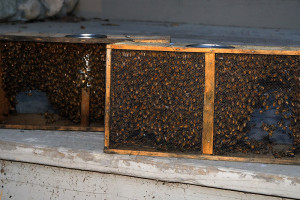
The packages of bees arrived at Curbstone Valley in the early evening, and were set on the workshop bench
If you order package bees, it’s always a good idea to ask how long ago the package was put together. In our case the bees had only been in the package for a few hours, and were not yet accepting of their new Queen, so it was imperative not to hive our packages too soon, or risk the worker bees absconding from the hive, and abandoning the Queen.
We left them in the workshop, where it’s dry and out of drafts. The bees had plenty of food available in the central syrup container in the package to last a couple of days before being hived.

The can in the enter of the package contains enough syrup for the bees for a few days. The metal tab to the left is suspending the caged Queen in the center of the container
Late on Saturday afternoon, as the temperature outside was cooling, we collected all of the equipment necessary to house these two packages. In addition to the hive equipment we gathered some basic tools:
– A pocket multi-tool with flat-head screwdriver and pliers
– A dish towel
– A small saucer
– Mini-marshmallows
– Bee brush
The lower hive body was set on the stand, and half of the frames were removed to make room for the bees.
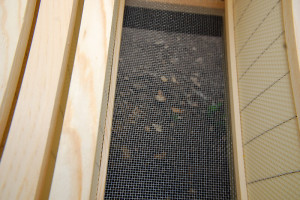
By removing a few frames, you ensure the bees don't slide off the frames onto the ground during installation
We first carefully, and slowly, pried the can of syrup up out of the top of the package, and immediately covered the resulting hole in the box with a dish towel to keep the majority of the bees inside the package. We then straightened the tab holding the Queen cage, and carefully removed the cage from the package. We re-covered the hole in the package, and secured it with the saucer over the hole so we could work with the Queen with minimal interference from the worker bees.
There are various styles and configurations of Queen cages, and it’s important to know which type of cage you have before proceeding. When we collected the packages we were advised that there was only a solitary cork over the opening in the Queen cage. Pull the cork, you release the Queen. Some Queen cages have a cork, and either a candy plug underneath, or a second hole in the cage plugged with candy. What you don’t want to do is pull the cork, have the entrance wide open, and accidentally release your Queen. Either your Queen will take off, or the workers may commit treason, and kill the Queen if she’s released too early.
Mr. Curbstone had to quickly remove the cork, and immediately…no I mean instantaneously cover the exit hole with his thumb. Queens are lightning fast, and you need to be even faster plugging that hole. Rule number one of hiving a package…DON’T LOSE THE QUEEN! Rule number two, be brave and DON’T WEAR GLOVES WHEN WORKING WITH QUEENS! Really, you can’t feel a darn thing, and are more likely to damage or crush the Queen.
With a thumb firmly blocking the exit, you grab your trusty mini-marshmallow and stuff it into the hole. As much as I abhor the notion of feeding anything containing corn-syrup to bees, and these days marshmallows are almost pure corn syrup (unless you make your own), it really is an excellent candy cork substitute.
Over the period of a few days the workers will slowly consume this junk food marshmallow, and release the Queen themselves. This provides a few extra days for the colony of workers to accept their new Monarch before she is released.
Once the hole in the Queen cage was plugged with the marshmallow it was time to install the Queen. In this case we simply hung the Queen cage from the top bar of a frame and used the adjacent frame to wedge the cage in position. Two things however are important when installing the Queen.
The first is to never position the mesh on the Queen cage up against foundation. It’s imperative that the worker bees have access to the Queen to feed her through the screen.
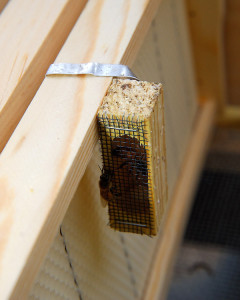
The bees must be able to reach the Queen. Face the mesh toward the end of the hive body, not toward the foundation
Second, if there are attendant bees inside the Queen cage with her, the candy cork should be positioned facing UP, not down. If the cork faces down, there’s a risk that the Queen can become trapped in the cage if one or more attendants die, and fall to the bottom blocking the exit. Facing the exit upwards means the exit can’t be blocked, and as soon as the candy is consumed, she will be free to enter the hive.
With the Queen in position it was time to install the workers. The package box was tapped once on the ground to cluster the bees at the bottom, then turned over the hive body, and a few gentle shakes emptied most of the bees into the hive body.
The package was then positioned in front of the hive and the remaining bees slowly found their way to the hive entrance.
We covered the hive body for a few minutes with the manipulation cloth to allow the bees to calm down. Once they’d settled down a little we then replaced the remaining frames into the hive body, and installed the feeder to ensure they have a nectar source while they’re drawing the new comb on the frames.
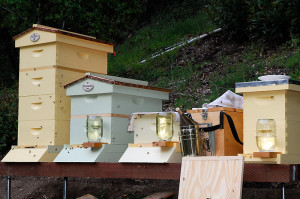
Once installed, we cover the hive bodies for a few minutes with a manipulation cloth while the bees settle down
We installed the second package the same as the first. The advantage of hiving the bees late in the day is that the bees have a natural inclination to hunker down at the end of the day, and stay closer to home, decreasing the likelihood of them absconding. Remember, they likely still have minimal allegiance to their new Queen.
The first package was installed in the Rosemary Hive. This hive from the outset behaved much more like the swarm colony in that they began to take orientation flights almost immediately, some workers were fanning at the entrance to signal the Queen was in residence, and the straggler bees had no difficulty finding the hive. These bees immediately began to consume syrup.
The second package, installed in the Chamomile Hive, was behaving a little differently. There was little to no activity at the hive entrance after installing the bees, no fanning bees, no coming and going through the entrance. The next morning we noticed that a small cluster of bees had remained at the top of the open package outside the entrance overnight. The bees also didn’t seem to be consuming much, if any, syrup. It’s possible this is just a variation of normal (having never installed packages before), and we expect that the bees in the Chamomile Hive may not yet be as accepting of their new Queen. By this morning however, the activity at the entrance of the Chamomile Hive seems more normal, and they’re now starting to consume syrup, and workers are heading into the field to forage.
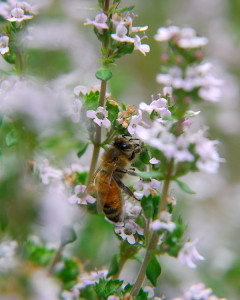
This worker was caught outside overnight amidst the thyme flowers. She took off once the sun warmed her up
The next step will be to re-enter both hives in a few days to make sure the Queen has been safely removed from the Queen cage. If she has not, providing the bees seem to have accepted her, we can release her manually, but if there’s any doubt as to her acceptance by the colony, it’s best to leave her for a couple more days.
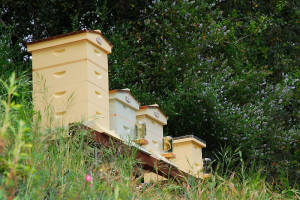
We now have four colonies of bees on the hive stand, Salvia, Rosemary, Chamomile, and the Nuc hive (soon to be the Lavender Hive)
As you can probably already tell, hiving a swarm seemed much more straightforward, with considerably less risk of things going awry. Overall though it went well, the Queens didn’t escape, and the bees seem to be settling in just fine.

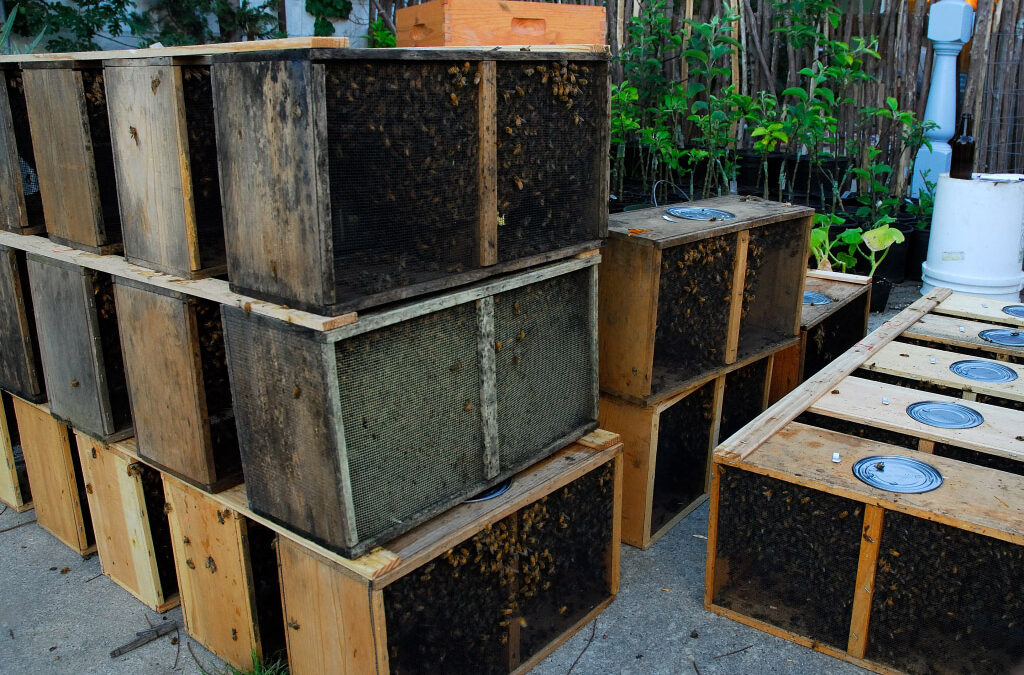


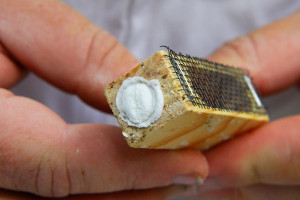

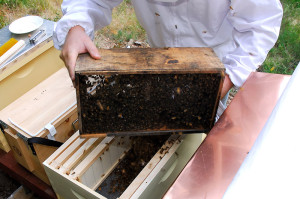
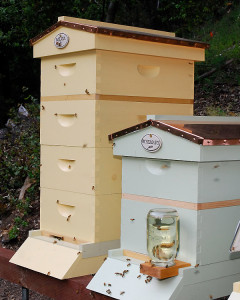







Interesting about the marshmallow! Our queen cage only came with a cork so we just left her in the cage a few days with the cork in and then released her when we were sure she had been accepted.
There are many ways to do this, and what you did is fine. The advantage with the marshmallow-method, though I’m not sure that’s the official term for it ;), is that if the weather turns, and becomes windy/rainy after installing the package, the bees should be able to release the Queen themselves. So if you can’t get back in the hive during bad weather, at least she’s not stuck in her cage. I must admit though, the stress of not letting the Queen escape during the marshmallow-stuffing procedure isn’t fun, but fortunately Mr. CV has nimble fingers 😛
Yippee!!! More bee stories!!! I love them!
Glad you enjoy them Stacey 🙂
Oh my. I had no idea how detailed the life of a beekeeper is. I have a new respect. Thanks for the lesson on beekeeping. I think I’ll leave that to the experts!
I have to admit, there’s much more keeping bees than even I first imagined. Once everyone is settled in though, and we get into a routine, it should be fairly easy. I hear the general rule that bees require more attention than a cat, but less than a dog…not sure that’s quite true, but close 😉
BTW Clare. I think you have the prettiest hives of all!
I do like how they look now, although if I don’t paint another hive part for a few weeks that will be a relief! I’m under no delusions that they’ll stay looking this nice though. With thousands of inhabitants each, and no maid, I expect they may look a little rough after next winter 😉
Hi,
Amazing photos, I honestly never realised Bee keeping could be so interesting… Although I do know I’d be way nervous of working or going near a Hive, as much as I love my Bees! 😀
Well, wearing the appropriate beekeeper’s suit of armor helps to banish most of the fear. I have to admit though, these Italian ladies were MUCH more feisty than our swarm bees! It will be interesting to see how they react to us when we take the Queen cages out.
Well told & funny too…loved the post!!! Look forward to more episodes Clare…thanks!
Thanks Susan 🙂
I’ll admit, you had me there when I saw a mini marshmallow on your list of “basic tools”. I didn’t think you were going to stop for a snack while installing the packages. 😀
Our package should be here next week. The hive is ready, and so is the beekeeper – I think! I will be reviewing my instructions before then. The internet is a wonderful thing. It’s so much more informative watching a Youtube video, or reading your blog!
To hear some of our veteran beekeeper’s talk at meetings, you start to assume that mini-marshmallows are standard issue in the beekeeper’s toolbox 😛 They worked great, but it would be tough to snack on them while wearing a veil!
I just want to thank you for documenting so carefully your beekeeping process. It is immensely interesting, and I am learning lots. Keeping bees is so important given the plight of the bees at the moment.
I enjoy it, and do it as much for myself so I remember what worked, and what didn’t! You’re right, I think all bees, not just the honey bees, need us to do what we can to ensure their survival at the moment, and we’re loving our foray into beekeeping so far! 🙂
Again fascinating post..wow it takes lots of learning and work but it is worth it..I love the hives and how you deal with the queen
What boggles my brain is how much effort we’ve put into learning about bees in the last 7 months, and how much we continue to learn, and still have to learn! I have a whole new respect for entomologists…insects are complicated! 😀
Dear CVF, This is a very impressive posting — You are so very knowledgeable about bee keeping! I must say I love how your hives look! I would like some in my garden, even without bees. P x
The hives are pretty, although I actually originally wanted the traditional English WBC hives. I’m sure you can find a decorative one there, in fact I think I saw one at Forsham Cottage Arks in their catalogue a year or two ago if you really want one…wait…here it is:
http://www.forshamcottagearks.com/garden-complements/hide-hive.htm
Clare,
Our package is due on the 17th. Should I install the honey super with the brood box, or wait until the bees start making brood first? You make it sound so easy..
Randy, I’d start with the brood box (I assume you’re using a deep 10 frame). You don’t have to wait for brood hatching to add supers though. Just keep an eye on them. Once you have 6-7 frames of drawn comb in the brood chamber I’d add the next box (will probably take a week or two). Some beekeepers though will maintain two brood boxes. If you’re doing that, add your second brood box in a couple of weeks, and then wait a little before adding a honey super. Truth is, it’s always best to err on the side of too much, rather than too little space, but if they’re drawing foundation (rather than working with drawn comb) you also want to encourage them to draw the comb out. Building up too fast, the bees tend to chimney up through the center most frames, and ignore the outer couple of frames completely. Good luck! I’ll be watching for when your bees arrive! 🙂
Wow, it was just like a day workshop in beekeeping 101. I am familiar with our native bees here as a child. I used to go with my father gather the honey from the wild, and i also have some share of stings and all that entails. I somehow have the basic knowledge about them as i took agriculture in college, however it is mostly skills to know the details of beekeeping. I love watching the beekeepers do them, and i appreciate your endeavor in keeping them for the environment. In our area even if we are not using pesticides, the honeybees seem to have gone away.
Honey bees across the globe are struggling, for many reasons other than pesticides. In Hawaii at the moment their colonies are being absolutely devastated by both the Varroa destructor mite (which they’ve only had a few years, and the bees aren’t yet adapted too), and now small hive beetle invasions. We’ve already been warned that Queens may be in short supply here next spring because of the state of hives there. Anything we can do to help keep local populations strong, I’m all for. I think the bees need all the help they can get!
I never knew I would enjoy learning about bees so much! Fascinating stuff. I am impressed by the bare hands I saw in the photos. I think I would want to be thoroughly covered, though I understand that’s not possible with the marshmallow corking procedure. Marshmallows! I do feel a bit sorry for the poor queen, stuck in her cage, hoping someone feels sorry enough for her to bring her food!
One member in our bee guild discovered that bees apparently love marshmallows. The little junk food junkies in their hive managed to release the Queen in less than 24 hours! Somehow I doubt she’ll starve, and she can always start eating the marshmallow from her side of the doorway 😉
Thanks for this Clare, I was wondering about the bees you ordered after hiving two swarms! If these are italian bees are the swarm bees considered ‘American’ bees?
I love these posts, read every word and click on each photo. Because of your clear explanations, I’m sure these posts would bee a great inspiration to would-be beekeepers.
I think more accurately our swarm bees are mutts. The Italian bees are all fairly uniform in color, but the swarm bees have a wide variation in color, some of which are very dark. At the very least, the current Queen seems to have found a variety of drones to mate with in the area.
It’s been fascinating following along as you get the hives going. My only close exposure to beekeeping was living with a hive that set up household in the back yard for four or five years. To think…bees sold by the pound? And since I don’t really care for marshmallows, it’s good to know that they have a reason to exist after all.
Clare, another fascinating post. I’m amazed at the amount of work necessary to install a hive and the intricacies of bee relationships.
The idea of catching a swarm produced a comical picture in my mind, though I was sure reality did not involve running around waving nets after passing bees (having now read your earlier post I see that this is so)
The whole process is fascinating – I look forward to further updates!
“We don’t usually transport 20,000 Italians in the back seat of our car.”
You are so awesome! Those hives look beautiful. Hope the bees all get along, and that there’s not too much carnage.
I wonder what the smallest size of mini-marshmallow package is. What on earth are you going to do with the rest? Make diminutive s’mores?
LOL. The smallest package I could find was 10 oz. I admit to nibbling on a few, but they’re really not very good. They’re fine for Queen cage corks, but barely qualify as food. Homemade marshmallows though are yummy pillowy goodness, although I haven’t made any in a while. I think rather than make mini s’mores, maybe I’ll just donate the rest of the bag to the Queen breeders in our bee guild 😉
I bet the chickens would love ’em.
You’re the coolest person EVER. 😀
Italian bees…designer bees! lol
If ever I wanted to keep bees, I would closely follow everything you write. Seriously, your blog ‘articles’ should be in a beekeepers mag. Even your hives are the bees knees down to the lovely name plates.
Clare, Another wonderful post~I’ve learned a lot from your experiences. gail